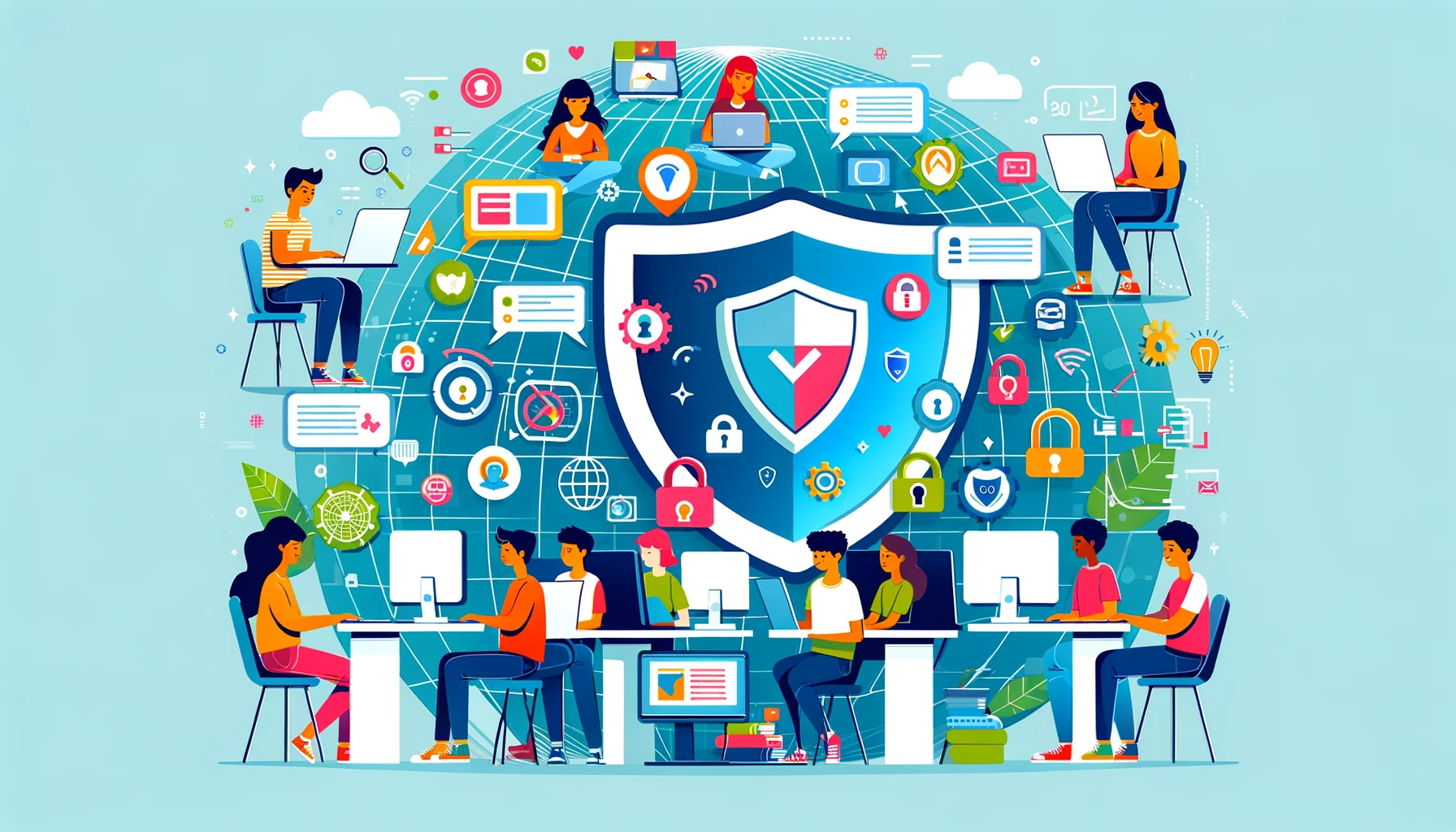Understanding Online Safety
What is Online Safety
Online safety, also known as internet safety or cyber safety, is the practice of protecting oneself and others from potential risks and threats that can arise when using the internet. This encompasses various aspects such as:
- Protecting personal information and privacy
- Avoiding dangerous situations like cyberbullying, online predators, and scams
- Ensuring the appropriate use of digital devices and online services
By developing the right habits and skills, students can navigate the digital world securely and efficiently.
Why Online Safety is Vital for Students
In today’s digital age, the internet has become an integral part of students’ lives, both for educational and recreational purposes. As a result, it is more important than ever to ensure their online safety. Here are a few reasons why online safety is crucial for students:
- Exposure to inappropriate content: Students can accidentally stumble upon explicit, violent, or illegal materials that may be harmful to their mental and emotional well-being.
- Online harassment and bullying: Cyberbullying is a widespread issue that can have significant psychological effects on its victims, especially in young people.
- Privacy concerns: Students need to be aware of the risks associated with sharing personal information and learn how to protect their privacy online to prevent identity theft or unwanted contact.
Educating students about online safety is essential to help them develop the knowledge and skills they need to navigate the internet responsibly and securely. By instilling awareness about online risks and promoting a culture of digital citizenship, students can harness the full potential of the internet while minimizing its dangers.
The Role of Technology in Online Safety
As technology becomes increasingly integrated into education, ensuring online safety for students is crucial. It is necessary to address various aspects of online security, such as managing privacy and securing personal information. Additionally, using antivirus and security software plays a significant role in reducing cyber threats.
Managing Privacy and Securing Personal Information
One of the primary concerns for students’ online safety is privacy protection. Students should be aware of the importance of privacy in the digital age to protect their freedom of thought and expression. Technology can be used to create resources and guidelines for students to manage their privacy settings. For example, many social media platforms and websites offer customizable settings to restrict access to personal information.
To protect online privacy, students should:
- Be cautious with sharing personal information on social media
- Use strong and unique passwords for different accounts
- Enable two-factor authentication when available
- Regularly update privacy settings on all devices and platforms
Additionally, educational institutions can develop resources and guidelines to educate students about data privacy and online safety, providing valuable information on how to secure personal information.
Using Antivirus and Security Software Properly
Antivirus and security software play a vital role in online safety. Ensuring that all devices used by students have updated security software can help prevent cyber threats, including malware and phishing attacks.
Students and educational institutions should:
- Install reputable antivirus and security software
- Regularly update software to address new security threats
- Configure security software settings for optimal protection
- Run frequent system scans to identify and remove potential threats
Technology can also support online safety by offering centralized platforms for communication and collaboration, reducing students’ exposure to external threats. Furthermore, implementing robust security measures within educational platforms can protect sensitive data and foster a safe learning environment.
In conclusion, the effective use of technology is critical in ensuring online safety for students. Educational institutions should prioritize creating resources and guidelines for privacy management and promoting the proper use of antivirus and security software.
Online Threats And How to Counter Them
Understanding Different Types of Cyber Threats
Students should be aware of various types of cyber threats that can potentially impact their online safety. Some common online threats include:
- Malware: Malicious software that can infect a computer or device, often spreading to other systems and causing damage or stealing sensitive information.
- Viruses: A type of malware that can self-replicate and infect other files and programs, disrupting the normal functioning of a device.
- Ransomware: A type of malware that encrypts files and demands a ransom for their release, often targeting sensitive and important data.
- Spyware: Malicious software that secretly monitors and gathers user data, often tracking online activities and personal information.
- Hacking: Unauthorized access to computer systems, often aiming to steal data, vandalize systems, or disrupt operations.
- Online predation: Cyber threats that involve targeting and exploiting minors through methods such as grooming, harassment, or extortion.
Steps to Counter Online Threats
There are several measures students can take to protect themselves from these threats:
- Keep systems and software up-to-date: Regularly update device operating systems, applications, and security software to patch potential vulnerabilities.
- Utilize strong, unique passwords: Create complex passwords and avoid reusing them across multiple platforms to prevent unauthorized access to personal accounts.
- Deploy a comprehensive antivirus solution: Install and maintain reputable security software on devices to proactively combat malware, viruses, and other threats.
- Be wary of suspicious messages and links: Avoid clicking on unfamiliar links or opening unsolicited attachments, as they can be a means of distributing malware or triggering phishing attacks.
- Limit sharing personal information: Remain cautious about the amount and nature of personal information shared online to reduce the risk of exploitation.
- Educate themselves about online threats: Stay informed about the latest cyber threats and learn how to recognize and report suspicious activities.
By following these guidelines, students can reduce the likelihood of falling victim to online threats and maintain a safe and secure digital environment.
Role of Educators and Parents

School’s Responsibility in Educating Digital Citizens
Educators play a pivotal role in teaching students about online safety and digital citizenship. They should ensure that students develop safe online habits, learn about potential cyber threats, and understand the appropriate course of action if faced with dangerous situations. Schools should incorporate cybersecurity education into their curriculum, helping students recognize common cyber threats such as:
- Phishing scams
- Malware and viruses
- Online bullying and harassment
Furthermore, schools should establish clear guidelines and regulations for responsible digital behavior within their community. Educators can organize workshops, seminars, and training sessions for both students and teachers on how to stay safe online and use the internet responsibly.
Parents Hand in Ensuring Online Safety
Parents have an equally important responsibility in ensuring their children’s online safety. They should be proactive in monitoring their child’s online activities and communicate openly with them about potential dangers they may encounter on the internet. Here are some steps parents can take to guarantee their child’s online safety:
- Set up parental controls and use content filters on devices.
- Establish and enforce rules for online behavior.
- Educate children about sharing personal information online.
- Encourage open conversations about online experiences and concerns.
- Create a collaborative approach with the child’s school, supporting a consistent message about internet safety.
Parents and educators should work together to create an environment of trust and understanding, guiding students towards becoming responsible digital citizens. With a joint effort between both parties, children can navigate the digital world securely and confidently.
Impact of Covid-19 on Online Safety

Online Safety Challenges During a Pandemic
The Covid-19 pandemic has caused a significant shift in the educational landscape. It has led to a rapid adoption of online learning platforms to ensure the continuation of K-12 education1. This increased reliance on remote learning has brought new challenges in terms of online safety for students.
During the pandemic, students spend more time online, which increases their potential exposure to cyber threats2. Some common online safety issues faced by students during the Covid-19 pandemic include:
- Cyberbullying
- Privacy breaches
- Exposure to inappropriate content
- Online scams and fraud
In addition to these threats, students may also face challenges related to digital literacy, such as understanding how to safely navigate online platforms and how to protect their personal information.
Strategies for Ensuring Safety During Remote Learning
To address the online safety challenges posed by the pandemic, schools, educators, and parents must implement strategies to help students stay safe online. Some of these strategies include the following:
- Creating clear guidelines: Develop a set of rules and best practices for students to follow when using online platforms for education3. This can include guidelines on appropriate online behavior, the importance of unique passwords, and the responsibility to report cyberbullying or other suspicious activities.
- Teaching digital literacy: Educators and parents should work together to teach students about online safety, including how to identify risks and protect their personal information. This can be done through lessons on cybersecurity, safe browsing habits, and responsible online behavior.
- Monitoring online activities: Monitoring tools can help track students’ online activities, allowing educators and parents to identify potential safety risks and intervene when necessary. However, it’s essential to balance monitoring efforts with respect for students’ privacy.
- Using secure remote learning platforms: Choose remote learning platforms with robust security features that protect user data and maintain students’ privacy4. Additionally, regularly updating software and using secured Wi-Fi signals can protect against cyber threats.
By recognizing the specific online safety challenges faced by students during the Covid-19 pandemic and taking proactive measures, schools, educators, and parents can help create a safer online learning environment.
Footnotes
- Importance of Online Safety for Students: Essential Tips and Strategies - June 1, 2025
- How to Use VPN with YouTube TV: A Quick and Easy Guide - June 1, 2025
- Soaked to Saved: The Art of Water Damage Data Recovery - June 1, 2025











1 thought on “Importance of Online Safety for Students: Essential Tips and Strategies”